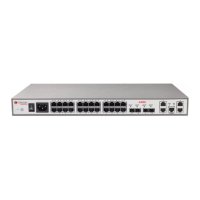A10E/A28E/A28F Configuration Guide
Best-effort
Best-effort service is the most basic and simplest service model over store and forward
mechanism Internet (IPv4 standard). In Best-effort service model, the application program can
send any number of packets at any time without permitting in advance and notifying the
network. For Best-effort service, the network will send packets as possible as it can, but
cannot guarantee the delay time and reliability.
Best-effort is the default Internet service model now, applying to most network applications,
such as FTP, E-mail, etc. which is achieved by First In First Out (FIFO) queue.
DiffServ
DiffServ model is a multi-service model, which can satisfy different QoS requirements.
DiffServ model does not need to maintain state for each flow. It provides differentiated
services according to the QoS classification of each packet. Many different methods can be
used for QoS packet classification, such as IP packet priority (IP precedence), the packet
source address or destination address and so on.
Generally, DiffServ is used to provide end to end QoS services for a number of important
applications, which is achieved mainly through the following techniques:
CAR (Committed Access Rate): CAR refers to classify the packets according to the pre-
set packets matching rules, such as IP packets priority, the packet source address or
destination address, etc. Continue to send the packets if the flow is in line with the rules
of token bucket. If it is beyond the specified flow, discard the packets or remark IP
precedence, DSCP, EXP, etc. CAR not only can control the flows, but also mark and
remark the packets.
Queue technology: the queuing technologies of SP, WRR, SP+WRR cache and schedule
the congestion packets to achieve congestion management.
4.1.2 Priority trust
Priority trust refers to the A10E/A28E uses priority of packets for classification and performs
QoS management.
The device supports packet priority trust based on interface, including:
DSCP (Differentiated Services Code Point) priority
CoS (Class of Service) priority
Interface priority
4.1.3 Traffic classification
Traffic classification denotes recognizing packets of certain class by setting rules, performing
different QoS policy for the packets match with different rules. It is premise and base of
diverse service.
The A10E/A28E supports traffic classification by IP priority, DSCP priority and CoS priority
over IP packets, as well as the classification by Access Control List (ACL) rule and VLAN ID.
The traffic classification procedure is shown below.

